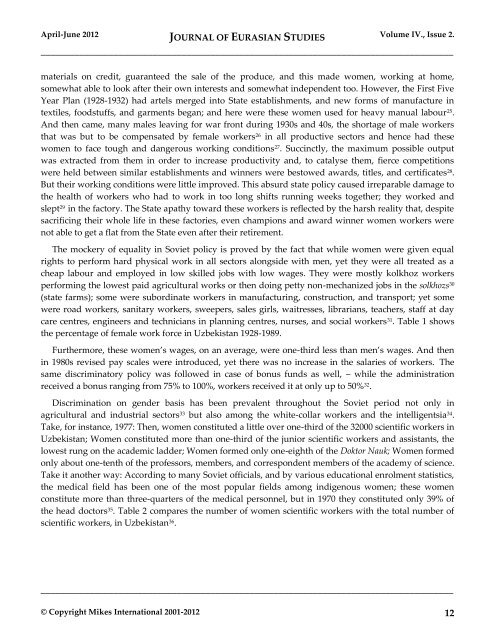You also want an ePaper? Increase the reach of your titles
YUMPU automatically turns print PDFs into web optimized ePapers that Google loves.
April-June 2012 JOURNAL OF EURASIAN STUDIES Volume IV., Issue 2.<br />
_____________________________________________________________________________________<br />
materials on credit, guaranteed the sale <strong>of</strong> the produce, and this made women, working at home,<br />
somewhat able to look after their own interests and somewhat independent too. However, the First Five<br />
Year Plan (1928-1932) had artels merged into State establishments, and new forms <strong>of</strong> manufacture in<br />
textiles, foodstuffs, and garments began; and here were these women used for heavy manual labour 25 .<br />
And then came, many males leaving for war front during 1930s and 40s, the shortage <strong>of</strong> male workers<br />
that was but to be compensated by female workers 26 in all productive sectors and hence had these<br />
women to face tough and dangerous working conditions 27 . Succinctly, the maximum possible output<br />
was extracted from them in order to increase productivity and, to catalyse them, fierce competitions<br />
were held between similar establishments and winners were bestowed awards, titles, and certificates 28 .<br />
But their working conditions were little improved. This absurd state policy caused irreparable damage to<br />
the health <strong>of</strong> workers who had to work in too long shifts running weeks together; they worked and<br />
slept 29 in the factory. The State apathy toward these workers is reflected by the harsh reality that, despite<br />
sacrificing their whole life in these factories, even champions and award winner women workers were<br />
not able to get a flat from the State even after their retirement.<br />
The mockery <strong>of</strong> equality in Soviet policy is proved by the fact that while women were given equal<br />
rights to perform hard physical work in all sectors alongside with men, yet they were all treated as a<br />
cheap labour and employed in low skilled jobs with low wages. They were mostly kolkhoz workers<br />
performing the lowest paid agricultural works or then doing petty non-mechanized jobs in the solkhozs 30<br />
(state farms); some were subordinate workers in manufacturing, construction, and transport; yet some<br />
were road workers, sanitary workers, sweepers, sales girls, waitresses, librarians, teachers, staff at day<br />
care centres, engineers and technicians in planning centres, nurses, and social workers 31 . Table 1 shows<br />
the percentage <strong>of</strong> female work force in Uzbekistan 1928-1989.<br />
Furthermore, these women’s wages, on an average, were one-third less than men’s wages. And then<br />
in 1980s revised pay scales were introduced, yet there was no increase in the salaries <strong>of</strong> workers. The<br />
same discriminatory policy was followed in case <strong>of</strong> bonus funds as well, – while the administration<br />
received a bonus ranging from 75% to 100%, workers received it at only up to 50% 32 .<br />
Discrimination on gender basis has been prevalent throughout the Soviet period not only in<br />
agricultural and industrial sectors 33 but also among the white-collar workers and the intelligentsia 34 .<br />
Take, for instance, 1977: Then, women constituted a little over one-third <strong>of</strong> the 32000 scientific workers in<br />
Uzbekistan; Women constituted more than one-third <strong>of</strong> the junior scientific workers and assistants, the<br />
lowest rung on the academic ladder; Women formed only one-eighth <strong>of</strong> the Doktor Nauk; Women formed<br />
only about one-tenth <strong>of</strong> the pr<strong>of</strong>essors, members, and correspondent members <strong>of</strong> the academy <strong>of</strong> science.<br />
Take it another way: According to many Soviet <strong>of</strong>ficials, and by various educational enrolment statistics,<br />
the medical field has been one <strong>of</strong> the most popular fields among indigenous women; these women<br />
constitute more than three-quarters <strong>of</strong> the medical personnel, but in 1970 they constituted only 39% <strong>of</strong><br />
the head doctors 35 . Table 2 compares the number <strong>of</strong> women scientific workers with the total number <strong>of</strong><br />
scientific workers, in Uzbekistan 36 .<br />
_____________________________________________________________________________________<br />
© Copyright Mikes International 2001-2012 12
















